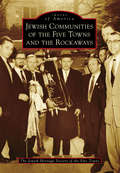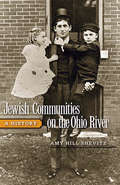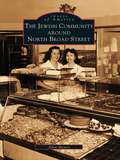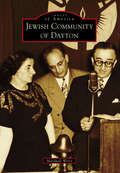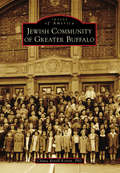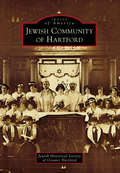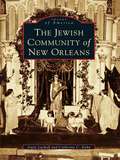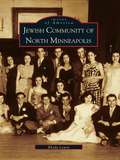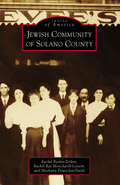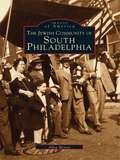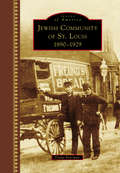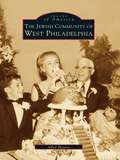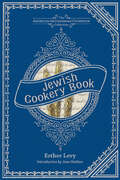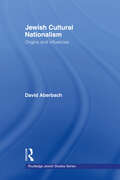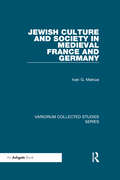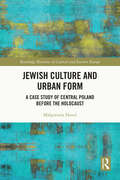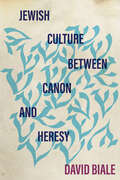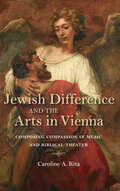- Table View
- List View
Jewish Communities of the Five Towns and the Rockaways (Images of America)
by The Jewish Heritage Society of the Five TownsThe Five Towns--comprising the villages of Cedarhurst and Lawrence and the communities of Woodmere, Hewlett, and Inwood--is an area nestled on the South Shore of Long Island next to the easternmost part of Queens, known as Far Rockaway. Originally popular as a Jewish summer vacation spot near the Atlantic Ocean, the Five Towns and the Far Rockaway area grew to become a thriving, year-round Jewish metropolis, with thousands of families and scores of synagogues and Jewish educational institutions. A center for shopping and kosher restaurants, the Five Towns area has become one of the most popular locations for young, married Jewish couples. Jewish influence has expanded greatly in local government and education. The rich history of the early years of Jewish growth and development in the Five Towns and Rockaways lends a deeper understanding of this phenomenal change of demographics and influence that has occurred over the last few decades.
Jewish Communities on the Ohio River: A History (Ohio River Valley Series)
by Amy Hill Shevitz&“An engaging regional history with immense national significance . . . An excellent chronicle of the minority experience in small town America.&” —Ava F. Kahn, author of Jewish Voices of the California Gold Rush In Jewish Communities on the Ohio River, Amy Hill Shevitz chronicles the settlement and development of small Jewish communities in towns along the river. In these small towns, Jewish citizens created networks of businesses and families that developed into a distinctive, nineteenth-century middle-class culture. As a minority group with a vital role in each community, Ohio Valley Jews fostered American religious pluralism as they constructed a regional identity. Their contributions to the culture and economy of the region countered the anti-Semitic sentiments of the period. Shevitz discusses the associations among the towns and the big cities of the region, especially Cincinnati and Pittsburgh. Also examined are Jewish communities&’ relationships with, and dependence on, the Ohio River and rail networks. Jewish Communities on the Ohio River demonstrates how the circumstances of a specific region influenced the evolution of American Jewish life. &“Far better composed and contextualized than most local histories of smaller Jewish communities now in print, Amy Shevitz&’s book does a commendable job of detailing local developments in terms of the broader picture of both American Jewish history and Ohio Valley history.&” —Lee Shai Weissbach, author of Jewish Life in Small-Town America: A History &“Shevitz&’s study provides both corroboration, and corrective, to the standard historiography of American Jewry . . . Shevitz provides a fascinating glimpse into the nature of small-town Jewish life, and the role Jews played in shaping their world.&” —Ohio Valley Quarterly
Jewish Community Around North Broad Street, The (Images of America)
by Allen MeyersThe cradle of Jewish life in Philadelphia began with the establishment of the first synagogue, Mikveh Israel, in 1740. With the influx of many German Jews in the 1840s, the community expanded above Spring Garden Street into the Northern Liberties neighborhood. Urban settlement of Philadelphia's Jewish population during the last quarter of the nineteenth century shifted to North Broad Street when the economy improved for the city's residents after the Civil War. North Broad Street soon boasted two elegantly designed synagogues and the newly relocated Jewish Hospital from West Philadelphia.The Jewish Community around North Broad Street weaves the tale of the Jewish community in this part of Philadelphia through a collection of rare and stunning images. The construction of the North Broad Street subway in the 1920s and the row house Jewish community known as Logan are parts of this story. The development of business districts led to a more cohesive north and northwest Jewish community that allowed for satellite Jewish enclaves to flourish, complete with their own synagogues, bakeries, kosher meat markets, and hundreds of other shops that served the general population. In the 1950s, new neighborhoods, such as Mount Airy and West Oak Lane, alleviated an acute housing shortage at a time when 110,000 Jews lived in north-central and northwest Philadelphia.
Jewish Community of Dayton (Images of America)
by Marshall WeissSince the arrival of approximately a dozen German-Jewish immigrants in the 1840s, the Jewish community of Dayton has actively contributed to the betterment and welfare of the "Gem City." Jewish Community of Dayton recalls forgotten stories of Arthur Welsh, the first Jewish airplane pilot; orphan turned social reformer Rabbi David Lefkowitz; Golda Meir's impassioned 1948 visit on behalf of the new Jewish state; and opera star Jan Peerce giving the final performance of his career with the acclaimed Beth Abraham Youth Chorale. This book illustrates how Dayton's Jews have responded and adapted to challenges ranging from the Great Flood of 1913 to resettlement of immigrants throughout the 20th century, from sacrifices for the state of Israel to activism in the civil rights era.
Jewish Community of Greater Buffalo (Images of America)
by Chana Revell KotzinJewish community life in Buffalo began in 1847 with the founding of Temple Beth El. A dominantly German Jewish community transformed in the 1880s as Eastern European Jews settled around William Street. Intense religious and commercial vibrancy emerged with new synagogues alongside Jewish grocery stores, kosher butchers, clothiers, and more. From this east side milieu, lyricist Jack Yellen ("Happy Days are Here Again") and composer Harold Arlen ("Over the Rainbow") emerged as part of a new generation shaping local and national American life. On the west side, Temple Beth Zion, the Jewish Federation, Jewish Community Center, Jewish Family Service, and Rosa Coplon Jewish Old Folks Home built institutions on and around Delaware Avenue. Jewish areas in Humboldt, North Buffalo, Kenmore, Amherst, Getzville, and Williamsville developed over time. Camp Lakeland continued earlier traditions of summer camping. Throughout the 20th century, Jewish Buffalonians made their marks as entrepreneurs, distinguished lawyers, award-winning writers, and Nobel Prize scientists, among other careers. The Jewish Community of Greater Buffalo showcases Buffalo and Niagara Falls Jewry over the last two centuries.
Jewish Community of Hartford (Images of America)
by Jewish Historical Society of Greater HartfordHartford’s Jewish presence dates back to the mid-1600s. The earliest permanent settlers were German Jews, who purchased the first building for use as a synagogue in 1856. With increasing immigration from Eastern Europe, the population soon expanded. Jewish-owned businesses became part of Hartford’s economic life, and numerous civic and social welfare organizations were established. In 1945, many philanthropic groups consolidated to create the Jewish Federation of Greater Hartford, which later relocated to West Hartford as the community shifted to the surrounding suburbs. Among the Hartford area’s most accomplished sons and daughters are entertainer Sophie Tucker, producer Norman Lear, comedienne Totie Fields, artist Sol LeWitt, and significant Zionist leaders, such as Samuel Hoffenberg and Abraham Goldstein. The Jewish Community of Hartford highlights some of the people and institutions that have helped to shape this remarkable community.
Jewish Community of Metro Detroit: 1945-2005, The (Images of America)
by Barry StiefelAfter the end of World War II, Americans across the United States began a mass migration from the urban centers to suburbia. Entire neighborhoods transplanted themselves. The Jewish Community of Metro Detroit: 1945 -2005 provides a pictorial history of the Detroit Jewish community's transition from the city to the suburbs outside of Detroit. For the Jewish communities, life in the Detroit suburbs has been focused on family within a pluralism that embraces the spectrum of experience from the most religiously devout to the ethnically secular. Holidays, bar and bat mitzvahs, weddings, and funerals have marked the passage of time. Issues of social justice, homeland, and religion have divided and brought people together. The architecture of the structures the Detroit Jewish community has erected, such as Temple Beth El designed by architect Minoru Yamasaki, testifies to the community's presence.
Jewish Community of New Orleans, The (Images of America)
by Irwin Lachoff Catherine C. KahnNew Orleans is not a typical Southern city. The Jews who have settled in New Orleans from 1757 to the present have had a very different experience than others in the South. New Orleans was a wide-open frontier that attracted gamblers, sailors, con artists, planters, and merchants. Most early Jewish immigrants were bachelors who took Catholic wives, if they married at all. The first congregation, Gates of Mercy, was founded in 1827, and by 1860, four congregations represented Sephardic, French and German, and Polish Jewry. The reform movement, the largest denomination today, took hold after the Civil War with the founding of Temple Sinai. Small as it is in proportion to the population of New Orleans, the Jewish community has made contributions that far exceed their numbers in cultural, educational, and philanthropic gifts to the city.
Jewish Community of North Minneapolis (Images of America)
by Rhoda LewinThe stories of the Jewish community of North Minneapolis are an important part of the rich and diverse mosaic of North Minneapolis history. By 1936, there were more than 16,000 Jew in Minneapolis, and 70 percent of them lived on the North Side. The Jewish Community of North Minneapolis presents an intriguing record of the earliest beginnings of Jewish communities in the city. Through the medium of historic photographs, this book captures the cultural, economic, political, and social history of this community, from the late 1800s to the present day. The Jews in North Minneapolis enjoyed a busy social and cultural life with their landsmanschaften, and shopped together at the kosher butcher shops and fish markets, grocery stores and bakeries, clothing stores, barber shops, restaurants, and other small businesses that had sprung up along Sixth Avenue North and then Plymouth Avenue. Including vintage images and tales of the community-Hebrew schools, synagogues, and social groups-this collection uncovers the challenges and triumphs of the Jewish community.
Jewish Community of Solano County (Images of America)
by Rachel Rae Moncharsh-Lessem Shoshana Deutscher-Nurik Rachel Raskin-ZrihenThis book contains images and stories of some of the Jews who have impacted Solano County. It is not a record of every Jew to pass this way, some of whom may have come intending to shed their Jewish identity by changing their names or converting. Wonderful stories emerged about extraordinary people who made their marks here with few suspecting their Jewish roots, yet they were traceable often because in death they chose to reclaim their heritage. Others came to live as Jews and built an enduring community. The story within these pages travels from the Old World to the edge of Gold Country, where there lives a tenacious, though often invisible, Jewish community.
Jewish Community of South Philadelphia, The: Images Of America (Images of America)
by Allen MeyersFor many Jewish immigrants to America, Philadelphia's row houses provided an instant community of neighbors where they were able to combine the traditions of the Old World with newAmerican ideals. In their flight to a new land and a new life, Jewish immigrants found a place to call home in South Philadelphia. This unprecedented collection of images celebrates the people and places of this community, from their struggles to their triumphs and the family bonds that provided their strength along the way. The Jewish Community of South Philadelphia is a tribute to tradition and pride that will serve as a valuable tool in teaching the history of Jewish immigrants in America. Join Allen Meyers in this exploration of the past that will be enjoyed for generations to come.
Jewish Community of St. Louis: 1890-1929 (Images of America)
by Diane EvermanThe St. Louis Jewish community began in the early 19th century and increased rapidly in the decades surrounding the turn of the century. Jewish immigrants brought skills and determination that helped the community evolve and prosper, but they faced challenges to survive, acculturate, and flourish. Not everyone had easy lives or great wealth, yet most worked to succeed and help others. Jewish endeavors covered all spheres, from small businesses to the Freund Bakery and Stix, Baer and Fuller Department Store to the Lesser-Goldman Cotton Company. Many garment district businesses were owned and run by Jews. Philanthropy and social betterment created the Young Men's Hebrew Association, the Jewish Sanatorium, the Home for Aged & Infirm Israelites, the Jewish Hospital, and many other entities. Members of the Jewish community proudly served in World War I and participated in clubs and organizations, as well as in political, civic, and cultural affairs.
Jewish Community of Washington, D.C., The (Images of America)
by Dr Adam Garfinkle Jewish Historical Society of Greater Washington Dr Martin GarfinkleThe Jewish community of Washington, D.C., located in the political nexus of the United States, has often enjoyed attention from people of every level of influence, including the president of the United States. On May 3, 1925, Calvin Coolidge attended the cornerstone laying ceremony of the Washington Jewish Community Center. Herbert Hoover, as a former president, was vocal in his denunciation of Nazi Germany's treatment of the Jews. His voice garnered the support of many United States senators in 1943, including two from Maryland and one from Virginia. Ronald Reagan sent his personal regards to the Ohev Shalom Talmud Torah Congregation on their 100th anniversary celebration on April 10, 1986.
Jewish Community of West Philadelphia, The: Images Of America (Images of America)
by Allen MeyersThe Jewish community of Philadelphia west of the Schuylkill River is a composite of seven distinct neighborhoods surrounding West Philadelphia proper. These include Fortieth and Girard, Parkside, Wynnefield, Overbrook Park, Wynnefield Heights, Southwest Philly, and Island Road.A gathering of seventy-five thousand Jewish people in West Philadelphia during the twentieth century qualified the area known as "a city within a city" as a second settlement area. Excellent public transportation included the famed Market Street Elevated. The West Philadelphia Jews flourished and supported dozens of synagogues and bakeries, and more than one hundred kosher butcher shops at the neighborhood's height from the 1930s through the 1950s. Newly arrived immigrants embraced traditional Jewish values, which led them to encourage their offspring to acquire a secondary education in their own neighborhoods as a way of achieving assimilation into the community at large. The Jewish Community of West Philadelphia portrays Jewish life throughout West Philadelphia in the mid-twentieth century. The book captures rare, nearly forgotten images with photographs gleaned from the community at large.
Jewish Concepts of Scripture: A Comparative Introduction
by Benjamin D SommerWhat do Jews think scripture is? How do the People of the Book conceive of the Book of Books? In what ways is it authoritative? Who has the right to interpret it? Is it divinely or humanly written? And have Jews always thought about the Bible in the same way? In seventeen cohesive and rigorously researched essays, this volume traces the way some of the most important Jewish thinkers throughout history have addressed these questions from the rabbinic era through the medieval Islamic world to modern Jewish scholarship. They address why different Jewish thinkers, writers, and communities have turned to the Bible—and what they expect to get from it. Ultimately, argues editor Benjamin D. Sommer, in understanding the ways Jews construct scripture, we begin to understand the ways Jews construct themselves.
Jewish Consumer Cultures in Nineteenth and Twentieth-Century Europe and North America (Worlds of Consumption)
by Paul Lerner Uwe Spiekermann Anne SchenderleinThis book investigates the place and meaning of consumption in Jewish lives and the roles Jews played in different consumer cultures in modern Europe and North America. Drawing on innovative, original research into this new and challenging field, the volume brings Jewish studies and the history and theory of consumer culture into dialogue with each other. Its chapters explore Jewish businesspeople's development of niche commercial practices in several transnational contexts; the imagining, marketing, and realization of a Jewish national homeland in Palestine through consumer goods and strategies; associations between Jews, luxury, and gender in multiple contexts; and the political dimensions of consumer choice. Together the essays in this volume show how the study of consumption enriches our understanding of modern Jewish history and how a focus on consumer goods and practices illuminates the study of Jewish religious observance, ethnic identities, gender formations, and immigrant trajectories across the globe.
Jewish Cookery Book: On Principles of Economy (American Antiquarian Cookbook Collection)
by Esther LevyThis nineteenth-century cooking manual is the first Jewish cookbook published in America, and only the second written in the English language.Originally published in 1871, Esther Levy’s Jewish Cookery Book was written to help new immigrants adapt to life in the New World while maintaining their religious heritage; and it even includes a Jewish calendar as well as recipes for home doctoring. Levy’s cookbook follows Jewish law regarding cooking for the Sabbath, Passover, and other Jewish holidays; and it provides great detail about how to organize the household, and what steps to follow in conducting Jewish activities. The medicinal recipe section provides recipes for various ailments as well as cautions for visiting the sick. The book offers practical, down-to-earth advice for American-born Jews who did not have the benefit of a traditional Jewish education. This facsimile edition of Esther Levy's Jewish Cookery Book was reproduced by permission from the volume in the collection of the American Antiquarian Society, Worcester, Massachusetts, founded in 1812.
Jewish Cookery Book: On Principles of Economy (American Antiquarian Cookbook Collection)
by Esther LevyThis nineteenth-century cooking manual is the first Jewish cookbook published in America, and only the second written in the English language.Originally published in 1871, Esther Levy’s Jewish Cookery Book was written to help new immigrants adapt to life in the New World while maintaining their religious heritage; and it even includes a Jewish calendar as well as recipes for home doctoring. Levy’s cookbook follows Jewish law regarding cooking for the Sabbath, Passover, and other Jewish holidays; and it provides great detail about how to organize the household, and what steps to follow in conducting Jewish activities. The medicinal recipe section provides recipes for various ailments as well as cautions for visiting the sick. The book offers practical, down-to-earth advice for American-born Jews who did not have the benefit of a traditional Jewish education. This facsimile edition of Esther Levy's Jewish Cookery Book was reproduced by permission from the volume in the collection of the American Antiquarian Society, Worcester, Massachusetts, founded in 1812.
Jewish Cultural Nationalism: Origins and Influences (Routledge Jewish Studies Series)
by David AberbachJewish Cultural Nationalism explores the development of Jewish nationalism from the Bible to modern times, focusing on particular movements and places as well as texts which signified, or themselves brought about, change: the Bible (Hebrew prayer book), and the modern Hebrew literature, particularly in Tsarist Russia. While the influence of the Hebrew Bible alone on nationalism in individual periods has been subject to much scholarly study, the present work is unusual in its emphasis on the continuity of Jewish cultural nationalism and its influences through Hebrew texts.
Jewish Culture and Society in Medieval France and Germany
by Ivan G. MarcusThese studies explore the history of the Jewish minority of Ashkenaz (northern France and the German Empire) during the High Middle Ages. Although the Jews in medieval Europe are usually thought to have been isolated from the Christian majority, they actually were part of a 'Jewish-Christian symbiosis.' A number of studies in the collection focus on Jewish-Christian cultural and social interactions, the foundations of the community ascribed to Charlemagne, and especially on the fashioning of a martyrological collective identity in 1096. Even when Jews resisted Christian pressures they often did so by internalizing Christian motifs and turning them on their heads to argue for the truth of Judaism alone. This may be seen especially in the formation of Jews as martyrs, a trope that places Jews as collective Christ figures whose suffering brings about vicarious atonement. The remainder of the studies delve into the lives and writings of a group of Jewish ascetic pietists, Hasidei Ashkenaz, which shaped the religious culture of most European Jews before modernity. In Sefer Hasidim (Book of the Pietists), attributed to Rabbi Judah the Pietist of Regensburg (d. 1217), one finds a mirror of everyday Jewish-Christian interactions even while the author advances a radical view of Jewish religious pietism.
Jewish Culture and Urban Form: A Case Study of Central Poland before the Holocaust (Routledge Histories of Central and Eastern Europe)
by Małgorzata HanzlAcross a range of disciplines, urban morphology has offered lenses through which we can read the city. Reading the urban form, when conflated with ethnographic studies, enables us to return to past situations and recreate the long-gone everyday life. Urbanscapes – the artefacts of urban life – have left us the story portrayed in the pages of this book. The notions of time and space contribute to depicting the Jewish-Polish culture in central Poland before the Holocaust. The research proves that Jewish society in pre-Holocaust Poland was an example of self-organising complexity. Through bottom-up activities, it had a significant impact on the unique character of the spaces left behind. Several features confirm this influence. Not only do the edifices, both public and private, convey meanings related to the Jewish culture, but public and semi-private space also tell the story of long-gone social situations. The specific atmosphere that still lingers there recalls the long-gone Jewish culture, with the unique settlement patterns indicating a separate spatial order. The Author reveals to the international cast of practitioners and theorists of urban and Jewish studies a vivid and comprehensive account. This book will appeal to researchers and students alike studying Jewish communities in Poland and Jewish-Polish society and urbanisation, as well as all those interested in Jewish-Polish Culture.
Jewish Culture between Canon and Heresy (Stanford Studies in Jewish History and Culture)
by David BialeThis career-spanning anthology from prominent Jewish historian David Biale brings over a dozen of his key essays together for the first time. These pieces, written between 1974 and 2016, are all representative of a method Biale calls "counter-history": "the discovery of vital forces precisely in what others considered marginal, disreputable and irrational." The themes that have preoccupied Biale throughout the course of his distinguished career—in particular power, sexuality, blood, and secular Jewish thought—span the periods of the Bible, late antiquity, and the Middle Ages to the twentieth century. Exemplary essays in this volume argue for the dialectical relationship between modernity and its precursors in the older tradition, working together to "brush history against the grain" in order to provide a sweeping look at the history of the Jewish people. This volume of work by one of the boldest and most intellectually omnivorous Jewish thinkers of our time will be essential reading for scholars and students of Jewish studies.
Jewish Denver: 1859-1940 (Images of America)
by Jeanne E. AbramsIn 1859, during the Pike's Peak gold rush, at least 12 Jews joined the great migration to Colorado in search of gold and a brighter future. The unpredictability of mining and a growing demand for supplies encouraged many of these Jewish settlers to establish small businesses in Denver and in towns and mining camps across the state. By the early 1870s, Jewish benevolent societies and a congregation were established. Denver's dry, mild climate attracted patients with tuberculosis, and two Jewish sanatoriums were opened in the city around the beginning of the 20th century. Many of the predominantly Eastern European Jews who came in search of better health made Denver their home, thus augmenting the early Jewish population significantly. Today Jewish life flourishes in Colorado, and Jewish citizens continue to play a vital role in its culture and development.
Jewish Difference and the Arts in Vienna: Composing Compassion in Music and Biblical Theater (German Jewish Cultures)
by Caroline A. KitaThis study “brings to life a circle of writers and composers, with analyses of their major, minor . . . and forgotten works of Jewish music theater” (Abigail Gillman, author of Viennese Jewish Modernism).During the mid-19th century, the works of Arthur Schopenhauer and Richard Wagner sparked an impulse toward German cultural renewal and social change that drew on religious myth, metaphysics, and spiritualism. The only problem was that their works were deeply antisemitic and entangled with claims that Jews were incapable of creating compassionate art. By looking at the works of Jewish composers and writers who contributed to a lively and robust biblical theatre in fin de siècle Vienna, Caroline A. Kita shows how they reimagined myths of the Old Testament to offer new aesthetic and ethical views of compassion.These Jewish artists, including Gustav Mahler, Siegfried Lipiner, Richard Beer-Hofmann, Stefan Zweig, and Arnold Schoenberg, reimagined biblical stories through the lens of the modern Jewish subject to plead for justice and compassion toward the Jewish community. By tracing responses to antisemitic discourses of compassion, Kita reflects on the explicitly and increasingly troubled political and social dynamics at the end of the Habsburg Empire.
Jewish Displaced Persons in Italy 1943–1951: Politics, Rehabilitation, Identity (Routledge Studies in the Modern History of Italy)
by Chiara RenzoThis book focuses on the experiences of thousands of Jewish displaced persons (DPs) who lived in refugee camps in Italy between the liberation of the southern regions in 1943 and the early 1950s, waiting for their resettlement outside of Europe. It explores the Jewish DPs’ daily life in the refugee camps and what this experience of displacement meant to them. This book sheds light on the dilemmas the Jewish DPs faced when reconstructing their lives in the refugee camps after the Holocaust and how this challenging process was deeply influenced by their interaction with the humanitarian and political actors involved in their rescue, rehabilitation, and resettlement. Relating to the peculiar context of post-fascist Italy and the broader picture of the postwar refugee crisis, this book reveals overlooked aspects that contributed to the making of an incredibly diverse and lively community in transit, able to elaborate new paradigms of home, belonging and family.
